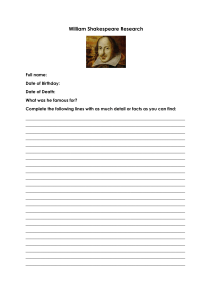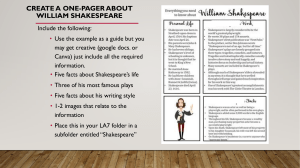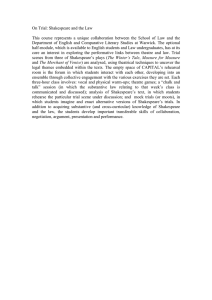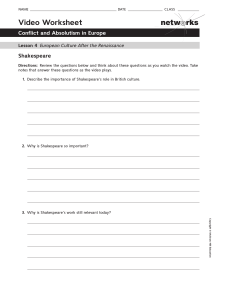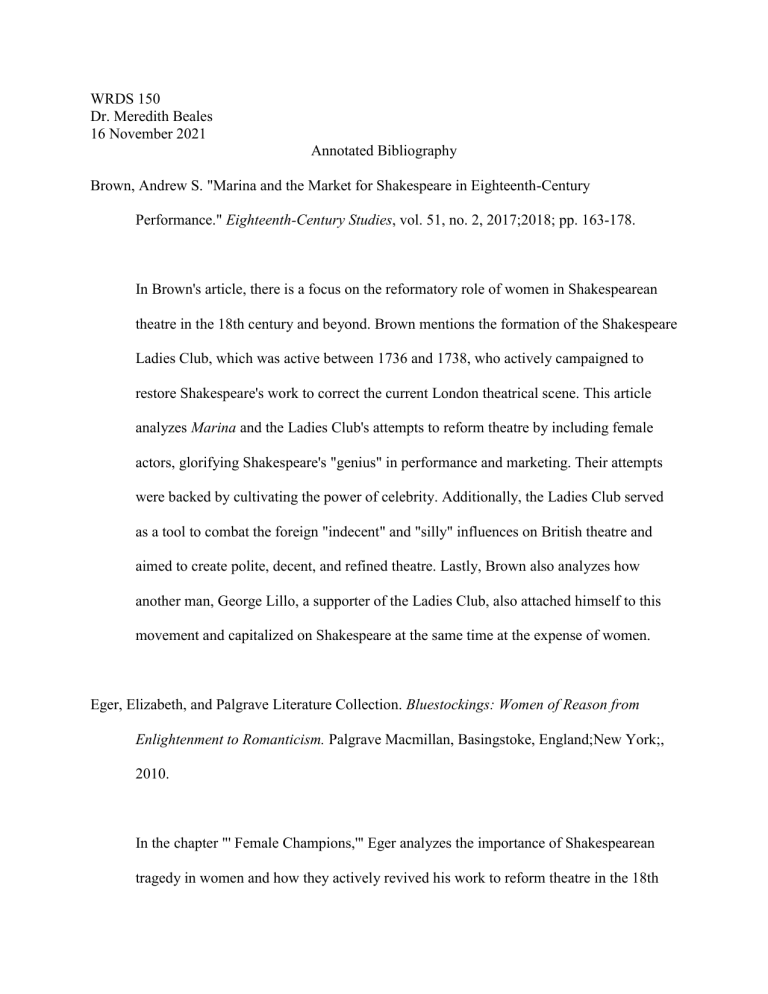
WRDS 150 Dr. Meredith Beales 16 November 2021 Annotated Bibliography Brown, Andrew S. "Marina and the Market for Shakespeare in Eighteenth-Century Performance." Eighteenth-Century Studies, vol. 51, no. 2, 2017;2018; pp. 163-178. In Brown's article, there is a focus on the reformatory role of women in Shakespearean theatre in the 18th century and beyond. Brown mentions the formation of the Shakespeare Ladies Club, which was active between 1736 and 1738, who actively campaigned to restore Shakespeare's work to correct the current London theatrical scene. This article analyzes Marina and the Ladies Club's attempts to reform theatre by including female actors, glorifying Shakespeare's "genius" in performance and marketing. Their attempts were backed by cultivating the power of celebrity. Additionally, the Ladies Club served as a tool to combat the foreign "indecent" and "silly" influences on British theatre and aimed to create polite, decent, and refined theatre. Lastly, Brown also analyzes how another man, George Lillo, a supporter of the Ladies Club, also attached himself to this movement and capitalized on Shakespeare at the same time at the expense of women. Eger, Elizabeth, and Palgrave Literature Collection. Bluestockings: Women of Reason from Enlightenment to Romanticism. Palgrave Macmillan, Basingstoke, England;New York;, 2010. In the chapter "' Female Champions,'" Eger analyzes the importance of Shakespearean tragedy in women and how they actively revived his work to reform theatre in the 18th century. Eger notes that women were the reason for the new upheaval of Shakespeare and thus began to act on stage, write plays, be novelists, readers and even critics of Shakespeare. There is also an analysis of how strong the cultural influence of women was in 18th-century British theatre and how they were able to begin actively criticizing Shakespeare's work in the public eye. Lastly, Eger also tackles the issue of women being presented as both consumers and commodities in Shakespeare. There are also additional feminist analyses on how the law denies women rights and treats them as property, but they own their writing and critique, something the law did not forbid them to have. Ritchie, Fiona, and McGill University. "Anna Larpent and Shakespeare." Aphra Behn Online, vol. 8, no. 1, 2018, pp. 0-16. In this article, Ritchie describes the background of Anna Larpent, a long-time follower of Shakespeare, and analyzes her engagement with his works as a woman in the 18th century (1-2). Larpent would keep a diary documenting the times she has seen a Shakespearean play and included her critique of every performance. Her critiques were noteworthy enough that it has made some adaptations change their casting or other theatrical elements. Ritchie also analyzes how Larpent writes about Shakespeare, how she feels about his work and how she thinks his work could be improved. Ritchie also clarifies how Larpent revolutionizes 18th-century theatre by stating her honest opinions about Shakespeare's work and keenly resisting bardolatry, which is surprising to many others in the theatre. Here, Ritchie attempts to highlight the influence of Shakespeare on women's education and the historical context of the Ladies Club in the early 18th century. McMullan, Gordon, Lena C. Orlin, and Virginia M. Vaughan. Women Making Shakespeare: Text, Reception, Performance. Bloomsbury Arden Shakespeare, London;New York;, 2014;2013;. This is a collection of 20-25 short essays that explore the important role of women in Shakespeare from the 17th century to now. In this collection, the authours attempt to use a diverse array of sources to analyze the topic deeper. There are script analyses from Shakespeare's plays, such as Edward III and James IV (5-8), which analyze the role of their female characters as warriors and not simply generative bodies. However, the authors examine elements in the plays that also hint towards treating women as "the second sex" even without actively "demonizing women” (12). Therefore, in this collection, a wide variety of critical perspectives are shared to fill in the gaps from previous research about the role of women in Shakespearean plays themselves and not simply their cultural relevance. The collection also examines women's influence on Shakespearean theatre starting in the 17th century of the Reformation period. Ritchie, Fiona. Women and Shakespeare in the Eighteenth Century. Cambridge University Press, New York, 2014. Ritchie fills in previous research gaps by analyzing the role of Shakespeare and women in the 18th century, as this period was a critical time for cultural enlightenment and feminist discourse in literature. She also discusses women's influences on theatre and Shakespeare's reputation after theatres reopening in Reformation England in 1660. The Reformation was the catalyst for the following changes in theatre and Shakespeare's growing popularity in England. Women's reverence of Shakespeare's work in the 18th century improved his reputation and led to cultural reform, where women began acting in English theatre. With this monograph, Ritchie demonstrates how women played a massive factor in circulating Shakespeare and changing the role of women in theatre after the Restoration. Lastly, she also highlights problematic critics and carefully critiques prologues and epilogues that hint towards misogynous tones in Shakespearean literature.
